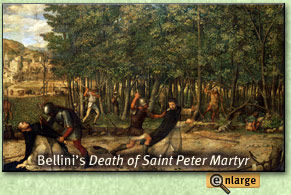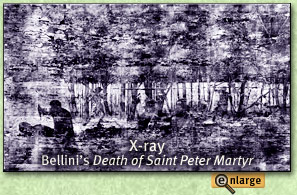|
|||||||||||||||
|

One of the central questions surrounding this painting, is what did it used to look like? No one knows, of course, but we can make educated guesses. In the Deconstruct section of this exhibit, we show our "reconstructions" of the first (Bellini) and second (Dosso) versions. How did we make these reconstructions?
We begin with documentary evidence, but find the history very thin. In 1568, Vasari published his Lives of the Artists, including false gossip that Bellini was too old to complete the Feast of the Gods and Titian was called in to finish. Contrary to Vasari, when scholars first looked at X-rays of the painting in the 1950s, they found Bellini had completed the entire painting. Moreover, they saw vestiges of the second (intermediate) version, but the identity of the second artist was still a mystery. Thirty years later, the intermediate painter was identified as Dosso during the comprehensive technical analysis and cleaning (1985-1990) of the painting. Of what we see today, the color-coded painting above-right illustrates who did what. Today, the painting consists of sections by Bellini, Dossi, and Titian, as identified. In some places, Titian may only have made slight alterations to the Dossi landscape. Reconstructing Bellini
Documents record that Bellini was paid for the Feast of the Gods in November 1514. His version featured a forested background and can be directly reconstructed from the X-ray and infrared. When the painting first hung in Ferrara in 1514, the figures were placed against a continuous row of trees. The tree trunks, ranging subtly in size, texture, and color, grew up and through the top of the picture, filling the upper half with lush, dense foliage. Between the trunks, the distant view of sky, mountains, and fields gave a feeling of great space beyond the trees. Its appearance would have been reminiscent of the background trees in Bellini's Death of Saint Peter Martyr, painted approximately ten years earlier. Here the scale is smaller and the closeness of the tree trunks and foliage provides a denser backdrop to the figures. In that painting, the story of Saint Peter Martyr, a Dominican friar and inquisitor, comes from the 'Golden Legend.' In 1252, he was ambushed on the road to Milan by assassins hired by local Cathar heretics. He was wounded in the head and stabbed repeatedly. His last action, shown here, affirms his faith - he is writing 'credo' ("I believe"), in his own blood. Peter Martyr was recognised as a saint by the Pope. He became an important figure for Dominicans, ranking alongside the founder of the order, Saint Dominic. X-rays show that the stance of Peter Martyr's murderer was changed from upright to stooping. Reconstructing Dossi Stylistic and circumstantial evidence suggest Dosso was the second painter. Although vague, numerous revealed features in the X-ray and infrared are not Bellini's. Dosso Dossi and his brother Battista decorated the ceiling and wall frieze of the Duke's private art gallery. What did Dossi's version look like? The evidence is tauntingly vague. Our reconstruction matches the main elements seen in the X-ray and infrared—the hill, ruins and trees—but it is much less certain than the reconstruction of Bellini's version. To gain a feeling for mood and coloring of Dosso's version, we superimpose backdrops from other Dosso landscapes. Since we do not know what the original looked like, these examples give us a flavor of how it might have appeared. Dossi altered Bellini's painting (1), repainting the backdrop behind the figures. Our Dossi reconstruction (2) retains the few Dossi features in the X-ray and infrared (ruin, trees, etc.), but alas, a definitive reconstruction is not possible. Possible Dossi backdrops are suggested by landscapes from other Dossi paintings (3-7). Touch the numbers above. What is by Titian? Documents record Titian's contribution to the Feast of the Gods. He probably made the changes during a visit to Ferrara in early 1529. Most of the landscape behind the figures is by him. Titian was the last painter, but how much of what we see is his hand? How much, if any, of the Dosso landscape did Titian leave? |
|
||






